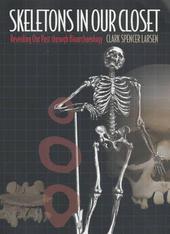
|
Skeletons in Our Closet: Revealing Our Past through Bioarchaeology
Paperback / softback
Main Details
| Title |
Skeletons in Our Closet: Revealing Our Past through Bioarchaeology
|
| Authors and Contributors |
By (author) Clark Spencer Larsen
|
| Physical Properties |
| Format:Paperback / softback | | Pages:272 | | Dimensions(mm): Height 235,Width 152 |
|
| Category/Genre | Archaeology
Human biology |
|---|
| ISBN/Barcode |
9780691092843
|
| Classifications | Dewey:599.947 |
|---|
| Audience | | Professional & Vocational | | Tertiary Education (US: College) | |
|---|
| Illustrations |
3 line illus., 32 halftones
|
|
Publishing Details |
| Publisher |
Princeton University Press
|
| Imprint |
Princeton University Press
|
| Publication Date |
3 March 2002 |
| Publication Country |
United States
|
Description
The dead tell no tales. Or do they? In this fascinating book, Clark Spencer Larsen shows that the dead can speak to us--about their lives, and ours--through the remarkable insights of bioarchaeology, which reconstructs the lives and lifestyles of past peoples based on the study of skeletal remains. The human skeleton is an amazing storehouse of information. It records the circumstances of our growth and development as reflected in factors such as disease, stress, diet, nutrition, climate, activity, and injury. Bioarchaeologists, by combining the methods of forensic science and archaeology, along with the resources of many other disciplines (including chemistry, geology, physics, and biology), "read" the information stored in bones to understand what life was really like for our human ancestors. They are unearthing some surprises. For instance, the shift from hunting and gathering to agriculture approximately 10,000 years ago has commonly been seen as a major advancement in the course of human evolution. However, as Larsen provocatively shows, this change may not have been so positive.Compared to their hunter-gatherer ancestors, many early farmers suffered more disease, had to work harder, and endured a poorer quality of life due to poorer diets and more marginal living conditions. Moreover, the past 10,000 years have seen dramatic changes in the human physiognomy as a result of alterations in our diet and lifestyle. Some modern health problems, including obesity and chronic disease, may also have their roots in these earlier changes. Drawing on vivid accounts from his own experiences as a bioarchaeologist, Larsen guides us through some of the key developments in recent human evolution, including the adoption of agriculture, the arrival of Europeans in the Americas and the biological consequences of this contact, and the settlement of the American West in the eighteenth and nineteenth centuries. Written in a lively and engaging manner, this book is for anyone interested in what the dead have to tell us about the living.
Author Biography
Clark Spencer Larsen is the chair of the Department of Anthropology and Distinguished Professor of Social and Behavioral Sciences at Ohio State University. He is a former president of the American Association of Physical Anthropologists and is currently Editor in Chief of the American journal of Physical Anthropology. He is the author of Bioarcheology: Interpreting Behavior from the Human Skeleton.
Reviews"In great detail, [Larsen] demonstrates how a competent expert may read an enormous amount from the subtle patterns present on bones... There is much in [the book] to provoke debate."--Publishers Weekly "Osteo-archaeology has certainly developed an impressive array of scientific tests that can be used to identify physical and biological stresses that is turn reflect lifestyle. Larsen goes into great detail to explain these methods and show how they can be used. His major theme and concern is the transition from a hunter-gatherer to a farming lifestyle some 10,000 years ago."--Hedley Swain, The Times Higher Education Supplement "The dead speak in Clark Spencer Larsen's new book. Chattering through worn teeth, gesturing with ossified limbs, theirs is the testimony of articulated bones... Larsen shows how he and other researchers in the emerging field of bioarchaeology have used skeletal evidence to challenge the tradition of equating the rise of agriculture with the betterment of the human condition."--Nina C. Ayoub, Chronicle of Higher Education
|